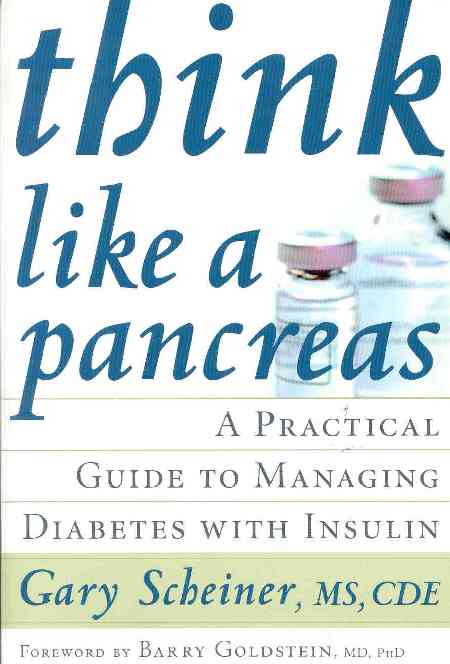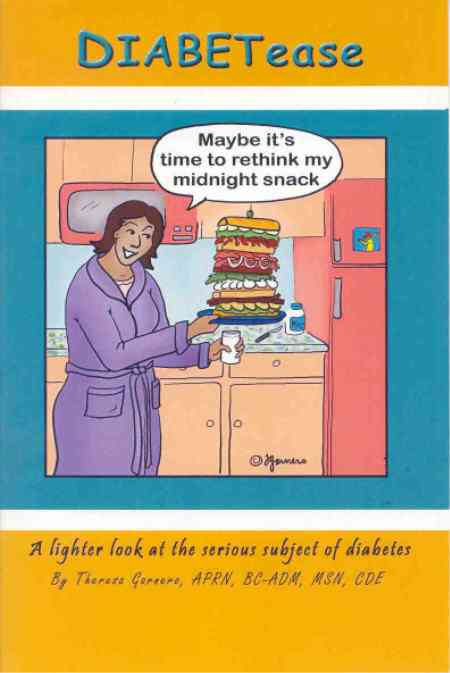
This newsletter keeps you up-to-date with new articles, Web pages, and books that I have written about diabetes.
- I list and link most of these on my at Diabetes Directory and in the site’s menu.
- From time to time Diabetes Update may also include links to other Web pages of special interest.
My recent contributions are:
- Meter News Column: Strip Costs
I am delighted to report that I am again writing a regular column for a diabetes publication. This is my third go at columnizing. Between 1997 and 2003 I reviewed diabetes-related Web sites for the American Diabetes Association in my column “About the Internet.” I also wrote seven columns for LXN Corporation’s website as the “e-Charged Newsletter” in 2001, until LifeScan bought LXN and discontinued the company’s site as well as all of its products, including the In Charge and Duet meters. Both sets of columns are now online at my site.By permission of the editor my new columns will also appear on my site following publication. My first “Meter News” appeared in the inaugural (June 2004) issue of Diabetes Health. While this is a totally new magazine, it is also the successor of Diabetes Interview, which was clearly the most cutting-edge diabetes publication. I am glad to say that Diabetes Health is even much better — and not only because it carries my column. In fact, I join with about a dozen other columnists, including Joy Pape, Deb Butterfield, and Steve Edelman.
The focus of my column is on meters that people with diabetes use to check their levels. Mostly it will deal with blood glucose meters, but my beat also includes home A1C testing (and fructosamine meters if anyone ever brings them back on the market). I will try to write about those aspects of testing that are new to most people. That means, of course, new products, but I interpret my responsibility to also include my takes on the whole field.
Please let me know your suggestions or ideas for future columns. My first column focused on the four brands of blood glucose meters (of a total of 14 brands) with the least expensive strip costs. The URL is
http://www.mendosa.com/metercolumn1.htm
Update:
- Policosanol
I was frankly surprised at the amount of interest in my article last month on cholesterol, http://www.mendosa.com/cholesterol.htm. It seems that many people have suffered the same (or worse) problems that I suffered at the hands of the biggest selling class of drugs in the world, the statins.Several correspondents suggested that I try an over-the-counter supplement, something that I had never heard of before called policosanol. It is quite interesting and appears to be an excellent alternative to any of the statins. See “Update: Policosanol” at the end of my Cholesterol article.

For All Insulin Users
- Think Like a Pancreas
I laughed out loud when I opened the package containing Think Like a Pancreas. With a title that flip I didn’t expect much.I couldn’t have been more wrong. Actually, the title makes sense, because it clearly reflects the author’s breezy style. Further, the style is paired with a greater depth of information on taking insulin than in anything else I have ever read. There is a lot that I didn’t know before and even more that I knew but not the reasons why.
The coverage of insulin use is so complete yet so accessible that I would have thought that it could only have been produced by someone who was an experienced journalist who had diabetes and is also a Certified Diabetes Educator. I was right on the last two points, by as far as I know the author, Gary Scheiner, is not a journalist. This is, however, at least his second book (he is the co-author of You Can Control Diabetes: A Personal Guide to Self Empowerment, a 340-page comprehensive reference on diabetes self-management). He also edited a journal for a couple of years, for which I can forgive him because I edited a magazine for a few years myself.
His treatment of how to handle both normal and severe lows alone is worth the price of admission, i.e. buying the book. Many people will find his comprehensive chapters on basal insulin dosing and bolus calculations just as valuable.
There’s a lot more here succinctly told in just 241 pages. While I wonder about certain details, the worst mistake that I caught was a misspelling of my name, which also can be forgiven.
The nation’s leading publisher of books on diabetes, Marlowe & Company in New York will bring out Think Like a Pancreas: A Practical Guide to Managing Diabetes with Insulin by Gary Scheiner, MS, CDE, on August 3 for $15.95. It will be available in most bookstores and from Gary’s website, http://www.integrateddiabetes.com. It is must reading for anyone who uses insulin.
- DIABETease:
A lighter look at the serious subject of diabetes
Laughter is the Best Medicine
Lots of books focus on the serious side of diabetes. It is truly no laughing matter. That’s why Theresa Garnero illustrated and wrote her book of cartoons.She works as a diabetes educator at Community Hospital of the Monterey Peninsula. That’s less than 40 miles from my home, but I haven’t had the opportunity to meet her. That’s something I regret, because she sounds like just the sort of upbeat person I appreciate. For example, she inscribed the autographed copy that she sent me with the wise words, “Keep laughing — it lowers blood sugar.”
Her book, DIABETease, is a 60-page paperback filled with 50 colorful, comical illustrations about diabetes. They inform us without the typical heavy load of seriousness and fear. She kindly authorized the use of one of these illustrations as this issue’s featured illustration.
Theresa isn’t maintaining that there is anything funny about diabetes. “Rather, it is the human condition that lends itself to humorous situations,” she says. “Since less than half the people with diabetes ever receive education about how it can be controlled, it’s not surprising to hear the dark side emphasized. I’ve found that diabetes cartoons to be a much needed sigh of relief.”
DIABETease: A Lighter Look at the Serious Subject of Diabetes lists for $16.99 softbound and $34.95 hard cover. Theresa donates half of her profits to diabetes research, which shows her commitment to those of us with the condition. The book is available directly from Theresa at her website, www.tgarnero.com, or tollfree at (877) 765-4386. You can also buy it at many bookstores, including Amazon and Borders. But Theresa earns higher royalties when you buy it directly from her, which means more money for diabetes research.
Research Notes:
- Vitamin D isn’t just to prevent rickets, osteoporosis, and falls and fractures any more. Preliminary research indicates that the lower the vitamin D concentration, the longer it takes for blood glucose levels to decline. People with a low level of vitamin D in the blood have poorly functioning insulin-producing cells and a poor response to insulin, even when blood sugar levels are normal.
Researchers Ken C. Chiu and three associates at the UCLA School of Medicine in Los Angeles based these findings on their study of 126 glucose-tolerant men and women. The American Journal of Clinical Nutrition published their findings as “Hypovitaminosis D is associated with insulin resistance and fl cell dysfunction” in Vol. 79, No. 5, 820-825, May 2004.
Many people don’t get enough Vitamin D. Unless you eat a lot of fish liver, take cod liver oil, or drink a lot of fortified milk, you won’t get much from your diet. Ice cream, cheese, and yogurt do not contain Vitamin D. Sunlight is the main source, but using sunscreen blocks not only harmful rays but also Vitamin D. People who are essentially housebound and those who live pretty far north are most at risk of not getting enough.
Taking a lot of Vitamin D certainly won’t cure insulin resistance. In fact, too much can also be harmful. It is the most toxic vitamin. Too much can increase calcium loss from bone and is linked to premature heart attack and arteriosclerosis. It can do damage at levels not much higher than the recommended level.
With a narrow window between the therapeutic and toxic level, you have to be especially careful when you take a Vitamin D supplement. Some people recommend that before considering Vitamin D supplementation, your physician should test your Vitamin D level.
The usual maintenance level is 10 mcg (micrograms) or 400 IU per day. In any case adults shouldn’t get more than 50 mcg (micrograms) or 2,000 IU per day. That is the Tolerable Upper Intake Level (UL) that the Institute of Medicine of the National Academy established in 1997 in “Dietary Reference Intakes for Calcium, Phosphorus, Magnesium, Vitamin D, and Fluoride.”
Vitamin D is certainly one case where more isn’t better. Unfortunately, less isn’t better either. Be careful.
Announcements:
- I Changed My Name
If you are confused that this newsletter is coming to you from a character who calls himself “David Mendosa,” not the “Rick Mendosa” that you expected to hear from, here’s the reason why. I am changing my official name now to use my Jewish name. The time to do that is as good as any because next month we are moving from the coast of California to Boulder, Colorado. We bought a house there a couple of weeks ago, and escrow closes August 6. In California it’s simple to change your name, since you can do it by “common usage.” That’s what I did when I moved back to California in 1977. In Colorado I will have to go to court to legally get my name changed, but I will do that. Meanwhile, you are welcomed to call me either David or Rick. - HTML Format
I send out Diabetes Update e-mail in HTML format, which all Web browsers and most modern e-mail programs can display. HTML has live links to all the sites named in the text so that with a simple click of a mouse you can connect to the site you have just been reading about. - My Guarantee
This newsletter is free and will never include advertising. Nor will I ever sell, rent, or trade your e-mail address to anyone.
Archives:
I now send out Diabetes Update once a month. Previous issues are online:
- Diabetes Update Number 1: Diabetes Genes of December 10, 2000
- Diabetes Update Number 2: DiabetesWATCH of December 18, 2000
- Diabetes Update Number 3: Starlix of January 3, 2001
- Diabetes Update Number 4: Native Seeds/SEARCH, Tepary Beans of January 17, 2001
- Diabetes Update Number 5: Insulin Makes You Fat of January 31, 2001
- Diabetes Update Number 6: Available and Unavailable Carbohydrates of February 15, 2001
- Diabetes Update Number 7: Dates of March 1, 2001
- Diabetes Update Number 8: Quackwatch of March 15, 2001
- Diabetes Update Number 9: The Cost of Insulin of March 30, 2001
- Diabetes Update Number 10: Sof-Tact Meter of April 2, 2001
- Diabetes Update Number 11: iControlDiabetes of April 16, 2001
- Diabetes Update Number 12: Cinnamon, Tagatose of May 2, 2001
- Diabetes Update Number 13: Glycemic Index of May 15, 2001
- Diabetes Update Number 14: Eat Your Carrots! of May 31, 2001
- Diabetes Update Number 15: Glycemic Load of June 21, 2001
- Diabetes Update Number 16: Homocysteine of July 2, 2001
- Diabetes Update Number 17: Chana Dal Tips of July 15, 2001
- Diabetes Update Number 18: Lag Time in AlternativeLand of August 2, 2001
- Diabetes Update Number 19: Fiber of August 15, 2001
- Diabetes Update Number 20: How Diabetes Works of August 30, 2001
- Diabetes Update Number 21: Insulin Resistance of September 14, 2001
- Diabetes Update Number 22: Trans Fats, Honey, CU of October 1, 2001
- Diabetes Update Number 23: Pedometer Power of October 15, 2001
- Diabetes Update Number 24: Is Glycerin a Carbohydrate? of October 31, 2001
- Diabetes Update Number 25: Kill the Meter to Save It of November 15, 2001
- Diabetes Update Number 26: Protein, Fat, and the GI of December 1, 2001
- Diabetes Update Number 27: Insulin Index of December 14, 2001
- Diabetes Update Number 28: Fructose of January 4, 2002
- Diabetes Update Number 29: Aspirin of January 14, 2002
- Diabetes Update Number 30: Stevia of January 31, 2002
- Diabetes Update Number 31: Gretchen Becker’s Book of February 19, 2002
- Diabetes Update Number 32: The UKPDS of March 4, 2002
- Diabetes Update Number 33: Financial Aid of March 18, 2002
- Diabetes Update Number 34: Pre-Diabetes of April 1, 2002
- Diabetes Update Number 35: More Glycemic Indexes of April 15, 2002
- Diabetes Update Number 36: Gila Monsters of April 30, 2002
- Diabetes Update Number 37: Is INGAP a Cure? of May 15, 2002
- Diabetes Update Number 38: Native American Diabetes of June 3, 2002
- Diabetes Update Number 39: FDA Diabetes of June 19, 2002
- Diabetes Update Number 40: Diabetes Support Groups of July 1, 2002
- Diabetes Update Number 41: New GI and GL Table of July 15, 2002
- Diabetes Update Number 42: Diabetes Sight of August 1, 2002
- Diabetes Update Number 43: DrugDigest of August 18, 2002
- Diabetes Update Number 44: Hanuman Garden of September 3, 2002
- Diabetes Update Number 45: Guidelines of September 16, 2002
- Diabetes Update Number 46: Trans Fat of October 4, 2002
- Diabetes Update Number 47: Nutrition.Gov of October 16, 2002
- Diabetes Update Number 48: Our Hearts of October 31, 2002
- Diabetes Update Number 49: Our Kidneys of November 15, 2002
- Diabetes Update Number 50: A1C<7 of December 2, 2002
- Diabetes Update Number 51: Diabetes Searches with Google of December 16, 2002
- Diabetes Update Number 52: e-Patients of January 2, 2003
- Diabetes Update Number 53: Email News of January 16, 2003
- Diabetes Update Number 54: Third Generation Meters of January 31, 2003
- Diabetes Update Number 55: Hypoglycemic Supplies of February 14, 2003
- Diabetes Update Number 56: Food Police of March 1, 2003
- Diabetes Update Number 57: Vitamins of April 1, 2003
- Diabetes Update Number 58: Lancets of May 1, 2003
- Diabetes Update Number 59: Accurate Meters of June 1, 2003
- Diabetes Update Number 60: Chromium of July 1, 2003
- Diabetes Update Number 61: Traveling of August 1, 2003
- Diabetes Update Number 62: My Book of September 1, 2003
- Diabetes Update Number 63: Hot Tubs of October 1, 2003
- Diabetes Update Number 64: Home A1C Testing of November 1, 2003
- Diabetes Update Number 65: Detemir of December 1, 2003
- Diabetes Update Number 66: Erectile Dysfunction of January 1, 2004
- Diabetes Update Number 67: Acidic Foods of February 1, 2004
- Diabetes Update Number 68: Net Carbs of March 1, 2004
- Diabetes Update Number 69: Glycemic Index of April 1, 2004
- Diabetes Update Number 70: Dreamfields Pasta of May 1, 2004
- Diabetes Update Number 71: Cholesterol of June 1, 2004
- I Changed My Name



